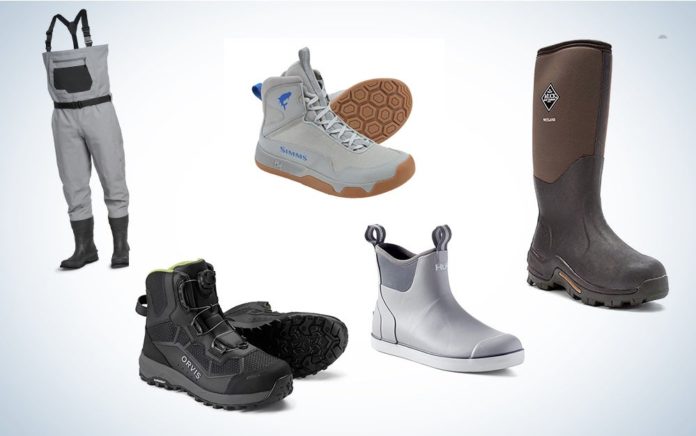Fishing boots are comfortable, durable, and keep you dry. They should be supportive enough that you always feel sure-footed. Dedicated anglers seem to always find themselves in slippery situations. Whether it’s an algae-covered river bed, wet boat deck, or icy boat launch—fishing conditions can be hazardous if you’re wearing the wrong footwear.
No one boot can handle all of the situations one might encounter when fishing, but the ones worth having all share some similarities. They provide all day comfort, offer the support needed to prevent injuries, and keep your feet planted no matter how treacherous the terrain is. The best fishing boots meet all these criteria and are made to last.
Things to Consider Before Buying Fishing Boots
Choosing the right pair of fishing boots can be tricky, especially if it’s your first pair. Every angler has their preferences and a lot depends on the style of fishing. Some prefer lightweight models while others choose heavier but more supportive boots. Whatever style an angler opts for, the boots should be comfortable, have good traction, and above all stand up against the elements. I have used many pairs of boots that last less than a season, especially if fished hard. Here are a few things to look for so the same doesn’t happen to you.
Materials
I look for boots with materials selected with the function of the boot in mind. This is a great starting point to ensure the boot is worth your time and money. Soles made of Vibram or similar traction-improving materials are great at keeping your feet planted in the wet conditions anglers encounter. I also look for boots made with durable materials, like synthetic fabrics and sturdy rubber, around key points like the heel and toe. This keeps the sole from separating in tough conditions and adds support.
Construction
Above all things, this is my deciding factor when choosing a boot. Regardless of materials, the boot needs to be put together in a way that ensures it stays together. Look at the key points like where the sole meets the boot and around the ankle. These areas are prone to blowing out after a few seasons so boots with reinforced connections are crucial.
Lacing System
All boots attach to your feet differently. Some have laces, others utilize quick-cinching BOA systems, and some don’t utilize any fasteners at all. Matching this to the style of fishing you do is the best bet to find the perfect fit.
Anglers wading in rivers need a secure connection, so laces or BOA systems are a great choice. But if you find yourself fishing in freezing temperatures, laces are the best bet. While BOA systems are great for quickly taking them on and off, I have had them freeze closed after a long day on the water.
Slip-on styles are great for deck boots and can be incredibly comfortable with no seams to make them fully waterproof. Similarly, Muck boots offer excellent waterproof performance and slip on and off easily.
Sizing and Fit
Fishing boots vary in size depending on what they are designed for. Deck boots run true to size and should match your typical shoe size. Wading boots, however, can vary greatly between brands and should be tried on with waders. If you plan on fishing through the winter, look for boots with extra room so you can add thick socks for warmth. Bootfoot waders can also be tricky and can run big, so trying them on before buying is a must.
Best Waders with Boots
Orvis Clearwater Bootfoot Wader Orvis
Why it Made the Cut
Durable and comfortable, the best bootfoot waders at an affordable price.
Key Features
- Available Sizes: 8-14
- Soles: Felt
- Lacing System: Slip-on
Pros
- Extra room for layers
- Easy on and off
- Waist-high conversion
Cons
- Not comfortable for long walks
My first pair of waders were a bootfoot model purchased in a general store. They were oversized and clunky, with a slow leak in one foot. I’m lucky I caught any fish trudging through the river in those. Now, I hit the river in the Orvis Clearwater Bootfoot Wader, which are a far cry from my first pair. They are the best pair of bootfoot waders I’ve used and are packed with features.
Unlike traditional neoprene waders, the Clearwaters are made from nylon fabric. This gives you plenty of room to move around. In addition, the nylon wicks moisture away keeping you dry and comfortable even during the summer months. But they get year-round use, becoming my go-to waders in wintertime. The boot provides great insulation, and the added room of a bootfoot design lets me wear heavy wool socks to stay warm. The boots themselves are made from vulcanized rubber with felt soles for the best traction available. For beginners or experienced anglers looking to save some money, these are a one-and-done option to get you on the water.
Best for Fly-Fishing
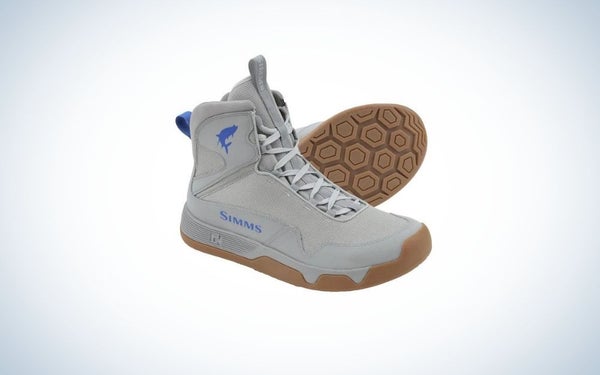
Simms Flats Sneaker Simms fishing
Why it Made the Cut
Lightweight and stealthy, the perfect boot for sneaking up on wary flats fish.
Key Features
- Available Sizes: 7-14
- Soles: Gum rubber
- Lacing System: Laces
Pros
- Laces keep the boots secure all-day
- A high tongue prevents sand and gravel from getting in
- Reinforced footbed for added comfort
Cons:
- Laces can wear out over time
One of the pinnacles of fly fishing is watching a tailing bonefish slurp down your fly and the chaos that ensues. Getting to these fish can be tricky with rocks, sharp corals, and the occasional stingray. The Simms Flats Sneakers are the best fly-fishing boots to get to those fish.
In shallow water, fish are always on high alert and will spook at the slightest disturbance. I find the gum rubber outsole of the Simms Flats Sneakers to be super quiet when wading and keeps you from slipping during a crucial moment. The soles are also boat friendly so you can jump in without slipping or scuffing the boat. My favorite feature is the long tongue that wraps tightly around your shin, keeping even the finest sand out of the boot for added comfort. During the summer they even double as a great pair of wet wading shoes when it’s too hot for waders.
Best Muck Boots
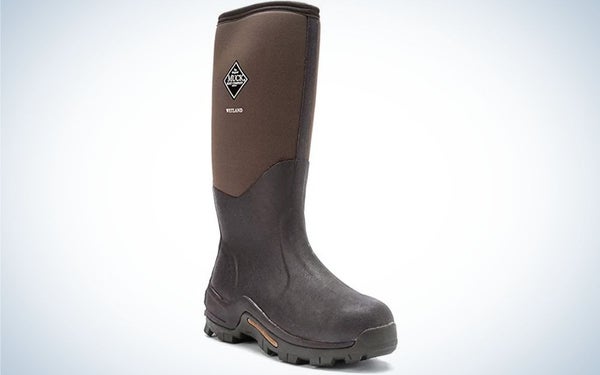
Muck Wetland Boot Muck Boot
Why it Made the Cut
The fully waterproof, calf-high design is great for shallow water wading and muddy conditions.
Key Features
- Available Sizes: 5-15
- Soles: Rubber
- Lacing System: Slip-On
Pros
- High sides extend the wading depth
- Fully waterproof
- Snug fit to keep them on your feet
Cons
You no longer have to worry about mud and shallow water with the Muck Wetland Boots. They’re the best Muck boots for fishing because they’re designed with anglers in mind. The calf-high design is one of the tallest in the company’s lineup. For shallow lakes or small streams, this is perfect to get to those just-out-of-reach places.
Even when conditions are less than ideal, the tread design ensures you will have traction. It features large and aggressive designs, and it excels at preventing mud and gravel from collecting so you don’t slip. They are easy to put on, and I can still wade to my favorite holes on a trout stream. Even in early spring when water temperatures are barely in the 40s, the 5mm neoprene construction is plenty warm enough. I always keep a pair in my truck for spontaneous trips.
Best Wading Boots
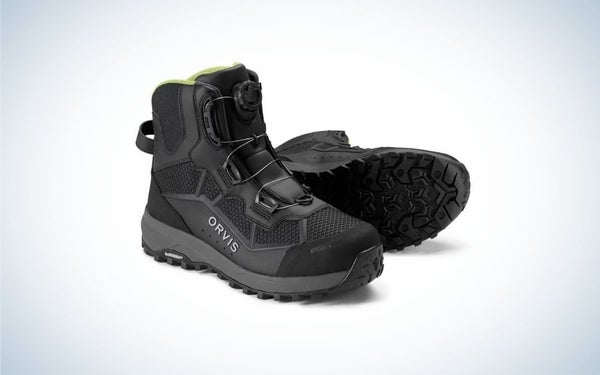
Orvis Pro Wader Boot Orvis
Why it Made the Cut
Cutting edge materials that are built to last years of abuse. The Orvis Pro Wader Boots are comfortable, durable, and supportive.
Key Features
- Available Sizes: 7-14
- Soles: Michelin Outdoor Extreme outsole
- Lacing System: BOA system
Pros
- BOA system offers quick on and off
- Rubber soles are super grippy
- Good ankle support
Cons:
- Add studs for the best grip
Finding a pair of wading boots that are comfortable and built to last can be tricky. The Orvis Pro Wader Boots are the answer, making them the best wading boots for fly fishing. Designed using an innovative PU-casting process, high wear areas avoid seams altogether. Every wading boot I have owned has inevitably failed at a seam, so eliminating them drastically improves the longevity of these boots. This construction also improves the rigidity of the boots providing added ankle stability.
The grip of these boots is one of its best features. Built in partnership with Michelin, the boots have a tire-like “Outdoor Extreme” outsole. That quality rubber tread gives these boots great traction, being incredibly sticky when you need them to be. On a recent trip to the Salmon River, I felt glued to the bottom even on the slickest slate shelves. For those looking for extreme grip, adding studs in the molded stud holes make it nearly impossible to lose your footing. To top it all off, the BOA grips are great for quickly taking them on and off, especially when another angler is eyeing your spot from the parking lot.
Best Deck Boots
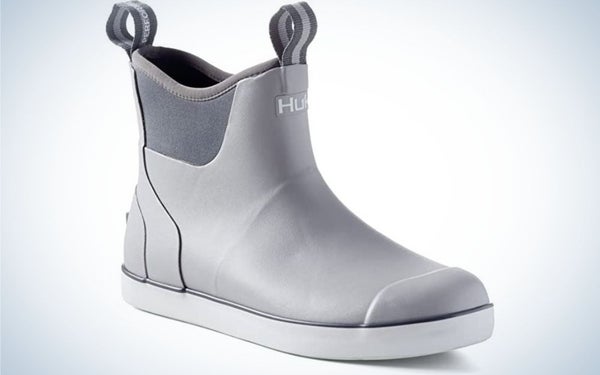
Why it Made the Cut
A true non-slip, waterproof deck boot designed to stand up to the abuse of saltwater fishing.
Key Features
- Available Sizes: 7-14
- Soles: Rubber
- Lacing System: Slip-on
Pros
- Non-marking outsole
- Neoprene upper provides insulation
- Reinforced seams
Cons
The Huk Rogue Waves are the best deck boots to keep you on your feet when it counts. These rubber boots are ankle-high with a full neoprene and rubber upper, and they keep you dry and comfortable. Like other deck boots, they slip on and off easily and can be worn with or without socks.
But it’s the non-skid sole design that makes this boot really shine. You no longer have to go barefoot all day because you don’t want to scuff your buddy’s white boat. I like to wear mine when throwing a cast net for bait. Running up and down the gunwales with a wet cast net full of fish makes for slick conditions. These boots make sure my bait reaches the live well and I stay dry.
How I Made My Picks
In my tenure as a saltwater and freshwater fisherman, I have accumulated more boots than I care to say and have gone through more than I ever thought possible. Speaking with industry professionals, guides, and more than a fair share of personal experience, I’ve learned to recognize what makes the best fishing boots. Materials, construction, and comfort all factor into making a good boot. Combine all three and you get a boot that is worth the money. No matter the kind of fish you pursue, one of these will do the job for you. Here are the criteria I based my selections on:
- Comfort: Does the boot fit well and feel comfortable.
- Weight: Are they light enough that your legs won’t tire out?
- Materials: What fabrics or polymers go into the boot?
- Soles: What kind of soles are there and what purpose do they serve?
- Lacing System: How do they secure your feet?
- Application: How do these fit into different fishing styles?
FAQs
Q: What are the warmest boots for fishing?
The warmest boots for fishing typically are made of neoprene or a similar material. Neoprene is great at insulating and will keep the heat from your feet in the boots. There are different thicknesses of neoprene, but 5mm is good for most applications. If you must wear waders, bootfoot models have extra room for thicker socks to keep heat in. The extra space also creates an air pocket that further insulates your feet.
Q: Do you wear boots with fishing waders?
There are two types of fishing waders: bootfoot and stocking foot waders. Stockingfoot waders do not come with boots, and a wading boot is worn over them. The stocking foot acts as a waterproof sock and goes inside the wading boot. This means the boot will get wet but your foot will stay dry inside the neoprene bootie. Bootfoot waders come with a built-in boot and are ready to go when you slide them on.
Q: How do I keep my feet dry when fishing?
If you plan on wading in rivers, waders are a must to keep you dry. The waterproof fabrics keep water out and allow you to wade into deep sections of the river. For bank and boat anglers waders are not necessary. A pair of waterproof boots made of neoprene or other waterproof materials work great. Boat anglers tend to prefer ankle-high deck boots for mobility. Bank anglers tend to prefer higher waterproof boots that allow them to wade up to calf height when needed
Final Thoughts
Fishing boots are extremely technique-specific and are a crucial part of enjoying your time on the water. Fly fishermen and anglers wading rivers should look for bootfoot waders or wading boots. Bank anglers can’t go wrong with Muck boots or Huk Rogue Wave boots.
Credit: Source link

















